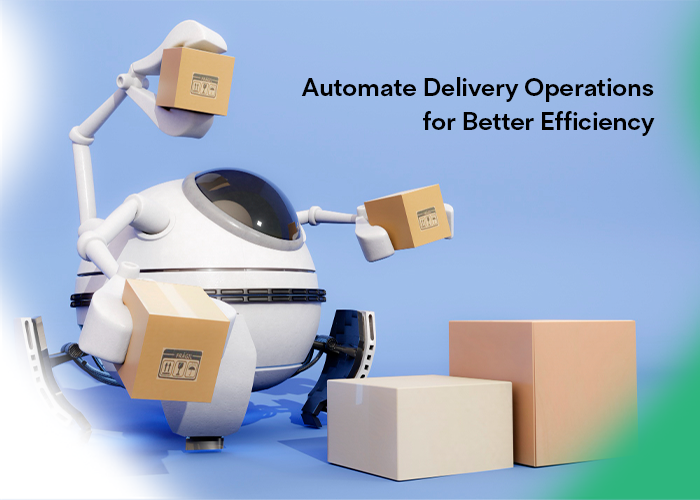We are in the age of technology – everything we do is dominated by technology. In the world of logistics and delivery, it isn’t any different.
Delivery operations have become the hotbed of technology deployment because the speed of delivery has become a crucial differentiator to be successful in today’s Delivery Model-led scheme of things. Automation is invaluable to optimize delivery operations and processes – it improves efficiency, minimizes costs, and achieves lasting customer satisfaction.
~~~ Automating your delivery operations enables you to expand your product offering, enter new segments, improve key operating metrics, and importantly, improve customer experience ~~~
This blog will focus on ways to best practices to optimize your delivery operations through the use of technology.
1) Analyze your existing delivery operations
- Current state, identifying problem areas: The first step is to conduct a thorough analysis of where your current process is. Are you still using manual operations? Are you partly automated? Is it disparate? Evaluate all parts of your existing delivery operations e.g. route planning, order processing, tracking, inventory management, and customer interaction. Identify tasks that are lengthy, inefficient, cumbersome, error-ridden, repetitive (etc.). These tasks should be replaced placed via automation
- Gaining insight through data analytics: Today’s data analysis provides deep and meaningful insight into business operations. It reveals key metrics, performance parameters, and patterns. Probe to see where automation can be of help i.e. to reduce costs, improve productivity, improve resource usage (etc.)
- Outline an automation plan: Unless your automation method is organized and implemented with clearly defined goals, necessary resources, and quantifiable benchmarks, you will not benefit from it. Your objectives must be consistent with your overall business objectives (improvements) that you seek via automation. e.g. to reduce delivery times by 25%
~~~ It is imperative to identify the areas where automation will help improve your business performance. Whether operational efficiency, cost-control measures, shortening delivery times, optimizing resource usage (etc.) the first step is to figure out where and how automation will improve your business metrics ~~~
2) Choosing the appropriate technology
- Investigate available automation options: Do a deep dive into the available technologies that most suit your needs. Be sure to check the reputation of the technology vendors, their SLAs (etc.)
- Flexibility and scale: These are of prime importance. As your company grows or adds complexities to its operations, the system must be able to adapt. Integrations with existing systems, led by API integrations, are another important consideration
- Costs: Quite obviously, everybody has a budget. There are various solutions available at multiple price points. A leading consideration is to calculate your ROI on the automation cost. Choose wisely.
3) Creating an effective implementation plan
Without an effective implementation plan, the best strategy in the world isn’t worth the paper it’s written on! Therefore, establish a detailed execution plan.
- Assigning deadlines and responsibilities: Outline a clear chart of deliverables, stakeholders and their responsibilities, and the role of each team member. Ensure clear communication lines to eliminate gaps or overlaps. Set up periodic review and progress meetings
- Conduct pilots: Automating delivery operations isn’t an easy task – it involves numerous aspects, and complexities, and can often veer off its originally projected plan. Therefore, conducting pilot tests is a solid way of testing the waters first. The learning from such pilot tests provides invaluable feedback for any course corrections or tweaks that must be introduced.
~~~ Pilot tests are a good way to test the waters before embarking on a whole-scale automation program. Select a good representative sample of the functions or processes so that the learning can be meaningfully extrapolated across your entire organization
It is also important that you study the results of the test pilots conducted. Were the solutions effective? Did they improve business functions in a manner you had expected them to? If not, why not? In cases of good results, can their performance be further improved? How? ~~~
4) Data analytics
- Data-led insight: With automation, comes the advantage of more data and information. And, with today’s robust data analytics, this provides deep insight that helps management make informed decisions. Processes from start-to-end, route optimization, resource utilization, and cost mitigation are just some areas that can be vastly improved via data-analytics
- Reducing data errors: Automation improves the quality as well as the comprehensiveness of data. Errors, duplication, formatting (etc.) are either completely eliminated or reduced to a negligible amount
- Compliances: Confidential information can be protected through numerous checks-n-balances, including limited access and encryption
5) Managing change
Remember, it is your employees that are responsible not only for implementing this change but also to work with the new system to make it a success.
- Employee training: This is critical in helping employees learn, adjust, and work the new system to their advantage. Provide training on how the new way will improve productivity and job satisfaction
~~~ To successfully adopt automation, companies must use techniques of change management. Create forums where employees can freely voice their thoughts – concerns, fears, hopes et all! Be sure to address all their concerns. Remember, change is difficult for everyone.
Explain how automation will benefit them, help them be better at their jobs, and achieve greater job satisfaction. Unless you get complete buy-in from your employees, it will become impossible to implement any such change ~~~
Unless you help employees to adapt – and, welcome – change that provides them with a more fulfilling workplace there will be friction. Chances are, the new system will run into numerous problems, and possibly even fail.
Make the process of implementing automation a collaborative one by seeking employee advice and including their suggestions. Employees that embrace automation will become natural advocates for it. Be sure to reward and recognize such employees through a formal Employee Appreciation Program.
Conclusion: As is evident, the process of adopting automation to optimize delivery operations must be approached in a well-thought-out and planned manner.
However, once the delivery software is implemented, not only does it improve the overall efficiency and cost of the delivery operation but it also improves several other key areas of the business. Ultimately, your business becomes more profitable and sustainable, with a base of loyal customers that provide you with repeat business.




